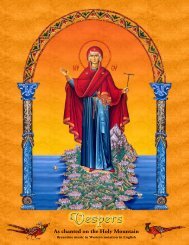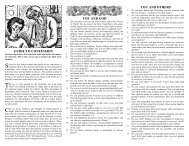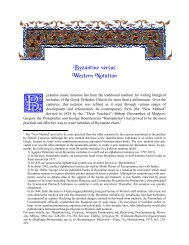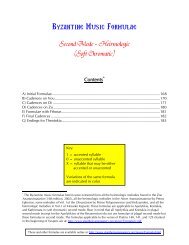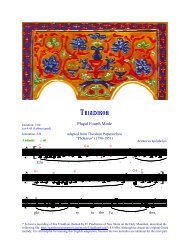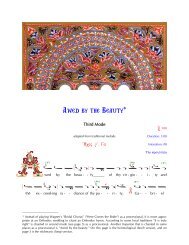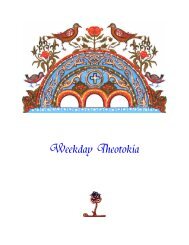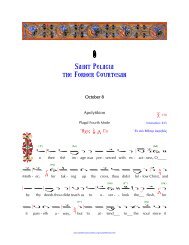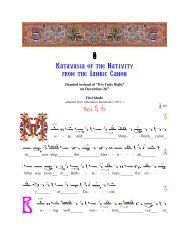Reading Psalmodia (PDF) - St. Anthony's Monastery
Reading Psalmodia (PDF) - St. Anthony's Monastery
Reading Psalmodia (PDF) - St. Anthony's Monastery
Create successful ePaper yourself
Turn your PDF publications into a flip-book with our unique Google optimized e-Paper software.
D] HARD and SOFT CHROMATIC<strong>Psalmodia</strong> makes use of two chromatic scales, the Soft Chromatic and the Hardchromatic. The relation between them in current practice is frankly quite obscure.Indeed, moving between them is probably the most difficult exercise in Tone to Tonemodulation. In Diagram H the two scales are presented side by side:Diagram HII (S.C) ------|--------------|--------|------------|--------|--------------|--------|PA VU GA DI KE ZO NIVI (H.C.) |------|--------------------|----|------------|------|--------------------|PA VU GA DI KE ZO NIIf, however, we take Raidestinos's proposal to see Ke as the basic note of the softChromatic scale, a very different, and much more intelligible pattern emerges, thatallows us to interpret much more easily the precise relation between the two forms ofChromatic scale.Diagram III (RAID) |--------|--------------|--------|------------|--------|--------------|PA VU GA DI KE ZO NIVI (H.C.) |------|--------------------|----|------------|------|--------------------|PA VU GA DI KE ZO NIThe two chromatic scales in this interpretation are close variants of each other: the notesPa, Di and Ke have the same pitches in the two scales, the chromatic intervals whichdefine Vou, Ga, Zo and Ni are closer to diatonic intervals in the soft scale and furtherfrom the diatonic in the Hard.15 MELODIC ACCENTSA characteristic feature of <strong>Psalmodia</strong> is the use of melodic accents, small decorations ormelodic flourishes, which mark accented notes in the melody. Flutter (petasti,) HeavyAccent (bareia,) Accented Diminuendo (psiphiston,) Ripple (omalon,) and Shake (antikenoma)are all used to indicate such melodic accents. In practice, different Psaltaiinterpret these signs in widely different ways. The following interpretation of the signsis, accordingly, no more than a suggestion. Individual teachers may have quite differentinterpretations to offer.Melodic accents are a normal part of Psaltic chant to the extent that a Psaltes willfrequently use them even when the musical text does not show them. A sequence ofsyllable sung on the same pitch or to a pattern of rising or falling seconds with not otheraccent than the stress or emphasis given by the rhythm of the chant is alien to<strong>Psalmodia</strong>. Faced with such a phenomenon, the Psaltes feels well-night compelled toadd tiny melodic flourishes to certain accented notes to enliven the chant. A well-writtenmusical text will normally indicate the melodic accents and their placing.The Flutter ( e ) is a common sign. It indicates a rise of one note (a second,) but unlikethe step (w ) it calls for a tiny melodic flourish at the start of the note which brightensand enlivens it. The Flutter is sung as follows: the Flutter indicates a rise to the step ofthe scale next above the one which precedes the Flutter, the voice rises to that pitch witha distinct attack, then a rapid ornament is sung in which the voice rises very briefly to




